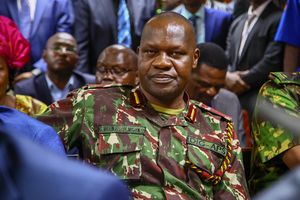As regional anchor state, Kenya needs to hone its art of peace

Kenya Defence Forces (KDF) soldiers attend a flag presentation ceremony by President William Ruto before their deployment to the Democratic Republic of Congo (DRC) as part of the East Africa Community Regional Force (EARDC) at the Embakasi Garrison in Nairobi on November 2, 2022.
Clearly, Kenya is a regional anchor state in Africa. This has seen demand for its peace diplomacy soaring.
As calls to broker peace in the Congo, Ethiopia, South Sudan, and Sudan increase, Kenya risks capacity overstretch. It needs to strengthen its peace-making capacity and hone its art of peace. In contrast to the art of war, the art of peace is the real essence of ‘soft power’.
During the Cold War, Kenya largely honed the art of war in its anti-colonial struggle, regional conflicts and in the global trenches of peacekeeping. In 1964, President Jomo Kenyatta signed a defence pact with Emperor Haile Selassie of Ethiopia. The aim was to contain Somalia, which claimed Kenyan territory and fuelled the ‘shifta menace’ (1963-1967). Kenya backed Ethiopia during its Ogaden War (1977-1978) with Somalia.
Kenya sought American help to modernise and strengthen its military to contain Idi Amin Dada. In February 1976, Amin claimed a large part of Kenya belonged to Uganda. But President Daniel Moi’s government allegedly aided Amin during the Kagera war (1978 –1979) as a ploy to contain socialist Tanzania.
Kenya also honed its art of war in the trenches of the United Nations and African Union peacekeeping. Kenya has ranked number 6 out of the 90 countries that contribute military and civilian police to UN operations. Its peacekeepers have served in 16 different countries in troubled parts of the world.
In 2011, Kenya entered Somalia under Operation Linda Nchi. But it joined the African Mission in Somalia (Amisom), now African Transitional Mission in Somalia (ATMIS), in 2011.
Kenya’s efforts to sharpen its art of peace during the Cold War came unstuck. In Congo, a rogue ‘army’ calling itself the Simbas captured Kisangani and took 1,300-odd foreign nationals, mainly Americans and Belgians, hostage. In September 1963, Prime Minister Jomo Kenyatta was called upon to mediate the crisis. But the mediation embarrassed Kenyatta after Washington’s paratroopers stormed Kinshasa and flew out the hostages.
Overthrew Okello
Kenya also burned its fingers in Uganda. On December 17, 1985, Moi brokered the Nairobi peace agreement between the Uganda Military Council headed by General Tito Okello Lutwa and the rebels of the National Resistance Army (NRA) headed by Yoweri Museveni. But Museveni’s NRA stormed Kampala and overthrew Okello without Moi’s knowledge.
Again, in 1988-1992, Kenya, through the Moi-era senior diplomat, Bethuel Kiplagat, engaged the warring parties in Ethiopia, but rebel forces seized Addis Ababa.
Within the Inter-Governmental Authority on Development (IGAD) framework, Kenya brokered the Somali peace deal in January 2004, which agreed on the formation of the Transitional Federal Government (TFG) and paved the way for the election of Abdullahi Yusuf Ahmed as the first post-Civil war president of Somalia. On January 9, 2005, its diplomats also brokered the Comprehensive Peace Agreement between the Sudan People’s Liberation Movement and the Government of Sudan. The accord ended the civil war and paved the way for South Sudan’s independence in 2011.
However, the return of the Cold War-era geopolitics between China and the US, the rise of populism and centrist regimes, and the surge of ethnonationalism and authoritarianism after 2014 forced Kenya back to the ‘art of war’.
After April 2018, a tripartite arrangement emerged in the Horn, involving Ethiopia, Somalia and Eritrea, ideologically based on ‘Cushitic Consciousness’ and weaved around the Horn Alliance (HoA). The new axis weakened IGAD and ushered geopolitical competition and tensions between Kenya and Ethiopia. The new rivalries in the Horn, with Jubaland as the eye of the storm, pushed Kenya-Somalia diplomatic relations to a low ebb.
But peace diplomacy is back, and so is IGAD as the security architecture in the Horn. A peace deal between warring parties in Ethiopia has silenced the guns in Tigray. After decades of absence, Eritrea has rejoined IGAD. Elections in Somalia (May 2022) and Kenya (August 2022) have fostered a conducive environment for the two neighbours to restore peaceful ties.
The time is ripe for Kenya to create a specialised agency to spearhead its peace diplomacy. An agency along the lines of the United States Agency for International Development (USAID) or South Africa’s African Renaissance and International Cooperation Fund (ARF) is central to the art of peace and soft power.
Prof Kagwanja is the co-author of Kenya's Uncertain Democracy: The Electoral Crisis of 2008 (London: Routledge, 1st edition, April 14, 2010).





